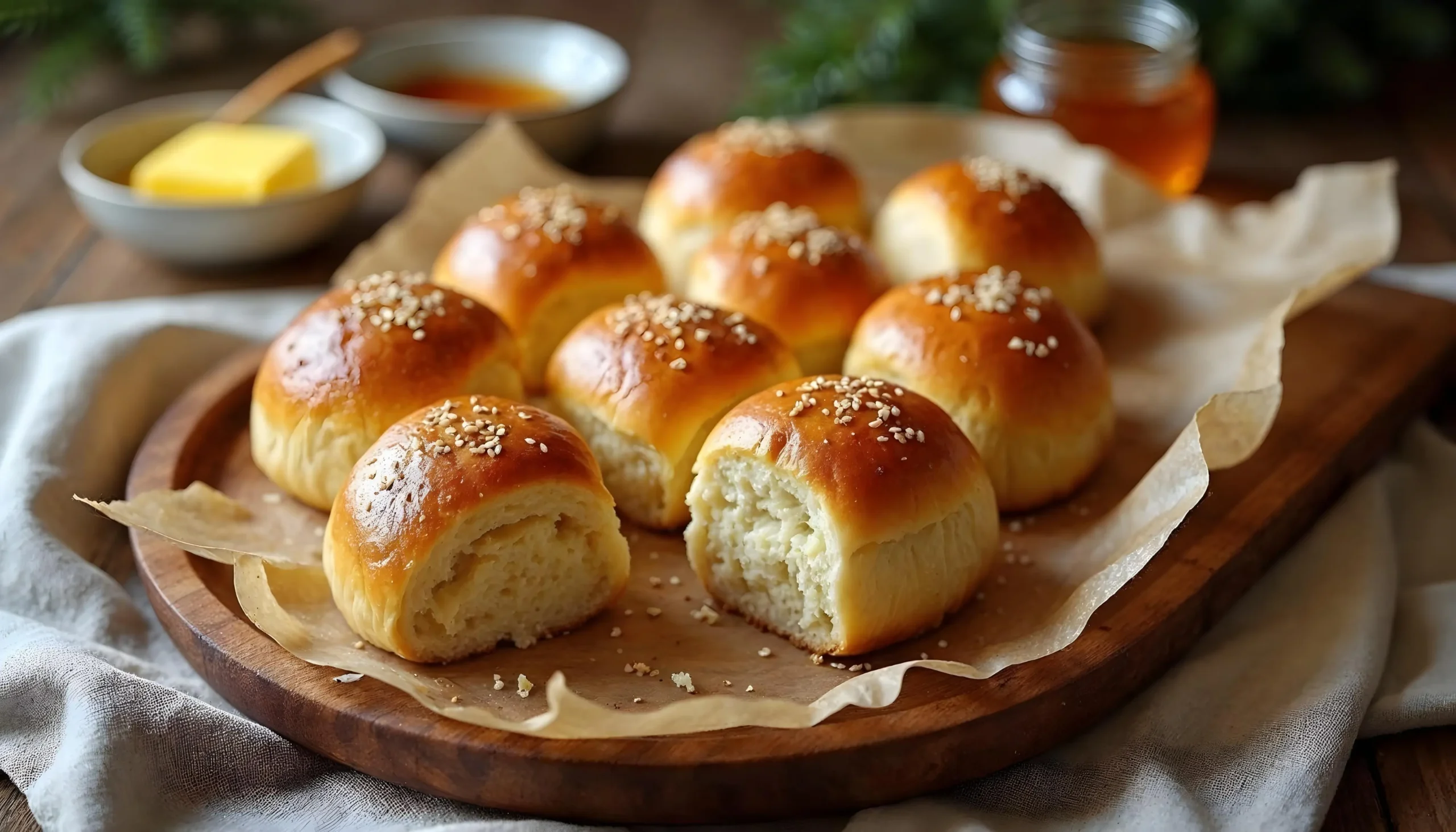When preparing dinner rolls, yeast is often the go-to ingredient to achieve the light, fluffy texture that makes them irresistible. The unique action of yeast, fermenting sugars in the dough to produce carbon dioxide, creates the airy, pillowy structure we all love. However, there are situations where yeast may not be an option—whether due to dietary restrictions like yeast sensitivities, allergies, or simply the unfortunate realization that you’ve run out of yeast in the middle of baking. These scenarios can feel frustrating, especially when you’re aiming to serve a perfect batch of rolls for family gatherings, holidays, or special dinners.
Fortunately, baking doesn’t have to come to a halt just because yeast isn’t available. In this article, we explore the best substitutes for yeast in dinner rolls, highlighting a variety of alternatives that ensure your homemade rolls remain delicious, fluffy, and satisfying. Whether you’re looking for quick-fix solutions or more flavor-enhancing substitutes, there’s a method to suit your needs.
Table Of Contents
Why Consider Yeast Substitutes?
Yeast serves as a vital leavening agent, helping dough rise by producing carbon dioxide bubbles during fermentation. This process not only contributes to the dough’s structure but also adds depth of flavor, making yeast an indispensable ingredient in traditional baking. However, substitutes can replicate this process effectively, delivering comparable results in terms of texture and rise.
One key advantage of yeast alternatives is their speed. Unlike traditional yeast, which requires time to proof and ferment, substitutes like baking powder or baking soda with acid react instantly, cutting down on preparation time significantly. This makes them an excellent choice for quick bread recipes or last-minute dinner rolls when time is of the essence.
Additionally, these substitutes offer flexibility for dietary considerations. Whether catering to individuals with yeast intolerance or those looking for a lighter, less fermented flavor, yeast-free options provide the versatility to create delicious baked goods that accommodate various preferences and restrictions. By exploring these alternatives, you can broaden your baking repertoire and ensure that a missing ingredient never stops you from serving up warm, fresh dinner rolls.
Best Substitutes for Yeast in Dinner Rolls

1. Baking Powder
Baking powder is a widely available leavening agent that combines an acid (usually cream of tartar) and a base (sodium bicarbonate). When mixed with liquid, it reacts instantly, producing carbon dioxide and causing dough to rise.
- How to Use: Replace 1 tablespoon of yeast with 1 tablespoon of baking powder.
- Pros: Quick, easy, and readily available.
- Cons: The texture might be slightly denser than yeast-based rolls.
2. Baking Soda and Acidic Ingredients
Baking soda alone does not work as a leavening agent; it requires an acidic component to trigger a reaction. Common acids include vinegar, lemon juice, buttermilk, or yogurt.
- How to Use: Combine ½ teaspoon of baking soda with 1 tablespoon of an acidic ingredient to replace 1 tablespoon of yeast.
- Pros: Creates light and fluffy rolls quickly.
- Cons: Can slightly alter the flavor depending on the acid used.
3. Sourdough Starter
A sourdough starter is a fermented mixture of flour and water containing natural wild yeast and lactic acid bacteria. It can effectively replace commercial yeast in dinner rolls.
- How to Use: Substitute 1 tablespoon of yeast with 1 cup of active sourdough starter, adjusting the liquid content in your recipe accordingly.
- Pros: Adds a tangy flavor and natural fermentation benefits.
- Cons: Requires preparation time if you don’t already have an active starter.
4. Egg Whites
Egg whites act as a leavening agent by incorporating air when whisked and folded into the dough. While not a direct replacement for yeast, they can add volume and lightness.
- How to Use: Beat 2 egg whites to stiff peaks and gently fold them into the dough.
- Pros: Adds richness and enhances texture.
- Cons: Works best in combination with other leavening agents for optimal results.
5. Self-Rising Flour
Self-rising flour contains baking powder and salt, eliminating the need for additional leavening agents.
- How to Use: Replace all-purpose flour with self-rising flour and omit yeast from the recipe.
- Pros: Simplifies the recipe and saves time.
- Cons: May require recipe adjustments for salt and flavor balance.
Adjusting Recipes for Yeast-Free Dinner Rolls
When replacing yeast, you may need to tweak other elements of the recipe:
- Liquid Content: Some substitutes, like baking powder or baking soda, react instantly with liquid. Mix ingredients quickly and bake immediately to avoid losing leavening power.
- Kneading: Unlike yeast dough, over-kneading is unnecessary for yeast-free alternatives. Focus on gently combining ingredients.
- Flavor Enhancers: Yeast contributes to flavor depth. Consider adding ingredients like garlic powder, herbs, or cheese to enhance the taste of your rolls.
Tips for PTips for Perfect Yeast-Free Dinner Rolls
Creating perfect yeast-free dinner rolls is easier than you think with a few adjustments. Follow these tips for delightful results:
- Preheat the Oven: Yeast-free dough relies on quick chemical reactions for rising, so a fully preheated oven is crucial. An under-heated oven can result in dense rolls.
- Use a Hot Baking Surface: A preheated baking stone or heavy-duty baking sheet ensures even heat distribution, giving your rolls a golden crust and well-cooked bottoms.
- Monitor Baking Time: Yeast-free rolls bake faster. Watch closely to avoid overbaking, which can make them dry. Look for a golden-brown top and use a toothpick to check doneness.
- Shape Consistently: Divide dough into evenly sized portions for uniform baking. This prevents some rolls from being overdone while others are undercooked.
- Avoid Overmixing: Mix dough just until it comes together to maintain a tender texture. Overmixing can make rolls dense by reducing the effectiveness of leavening agents.
- Bake Immediately: Yeast-free dough rises quickly due to fast-acting leavening agents. Bake rolls right after shaping to prevent a loss of volume.
- Enhance Flavor: Add garlic powder, herbs, cheese, or a touch of honey to compensate for the flavor depth yeast typically provides.
- Brush with Butter: For a glossy finish and added richness, brush rolls with melted butter before and after baking. Sprinkle with seeds or sea salt for extra flair.
By following these steps, you can create quick, fluffy, and flavorful yeast-free dinner rolls that are perfect for any meal, impressing everyone at the table.
Recipe: Quick Yeast-Free Dinner Rolls
Ingredients:
- 2 cups all-purpose flour (or self-rising flour if preferred)
- 2 teaspoons baking powder
- 1 teaspoon salt
- ¾ cup milk
- 2 tablespoons melted butter or oil
- Optional: 1 tablespoon sugar for a touch of sweetness
Instructions:
- Preheat your oven to 375°F (190°C). Grease a baking sheet or line it with parchment paper.
- In a large bowl, whisk together the flour, baking powder, and salt.
- Add milk and melted butter to the dry ingredients, mixing until a soft dough forms.
- Divide the dough into 8-10 equal portions and shape into rolls.
- Place the rolls on the prepared baking sheet and bake for 12-15 minutes or until golden brown.
- Serve warm with your favorite spreads.
Conclusion
Replacing yeast in dinner rolls is entirely possible with various substitutes, each offering unique benefits and versatility. Whether you opt for baking powder for its quick and effortless rise, sourdough starter to infuse your rolls with rich, tangy flavors, or baking soda paired with acidic ingredients for a soft, fluffy texture, you can achieve delightful results. These substitutes not only save the day when yeast is unavailable but also open up creative opportunities to experiment with flavors and textures in your baking.
Each alternative has its strengths: baking powder works well for those seeking convenience and simplicity, while sourdough starter provides a more complex, artisan-quality flavor. Self-rising flour simplifies the process by combining multiple components into one, and egg whites lend a unique lightness to the dough. Regardless of the method you choose, it’s essential to adjust your recipe slightly to ensure optimal results, such as modifying liquid content or baking times.
Remember, yeast-free dinner rolls are an excellent solution for those with dietary restrictions, allergies, or time constraints, offering a satisfying homemade alternative without sacrificing quality or taste. Whether for a last-minute dinner or an intentional twist on tradition, these substitutes prove that a lack of yeast doesn’t mean a lack of deliciousness. Try different combinations and recipes to discover what works best for your needs and elevate your dinner table with perfectly baked rolls every time.
Join the Baking Community!
Loved this recipe? Follow me on Facebook and Instagram for more delicious ideas, baking tips, and behind-the-scenes fun! Share your banana bread creations with me by tagging @panoramarecipes—I can’t wait to see what you come up with!
Happy baking, and don’t forget to share your delicious creations with friends and family. After all, good food is meant to be enjoyed together!


